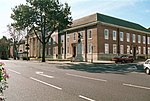Christ Church, Worthing

Christ Church and its burial grounds in Worthing, England, were consecrated in 1843 by the Bishop of Chichester, Ashurst Turner Gilbert, to meet the need for church accommodation for the poor. Built by subscription between 1840 and 1843, the Church was initially regarded as a chapel of ease to St Mary's Church in Broadwater. The chapel of ease was upgraded to the status of church with its own parish in 1855. Christ Church is the second oldest Church of England church still standing in Worthing town centre, after St Paul's Church which stands 100 metres to the east at the opposite end of Ambrose Place. Standing at 85 feet (26 metres) tall Christ Church is one of Worthing's most dominant flint buildings.The church was built mainly to provide church accommodation for the poor in Worthing, since the existing chapel of ease, now St Paul's Church, was funded as a proprietary chapel and so excluded the poor.
Excerpt from the Wikipedia article Christ Church, Worthing (License: CC BY-SA 3.0, Authors, Images).Christ Church, Worthing
Grafton Place,
Geographical coordinates (GPS) Address Nearby Places Show on map
Geographical coordinates (GPS)
| Latitude | Longitude |
|---|---|
| N 50.81258 ° | E -0.37359 ° |
Address
Grafton Place
Grafton Place
BN11 1AR , West Worthing
England, United Kingdom
Open on Google Maps









